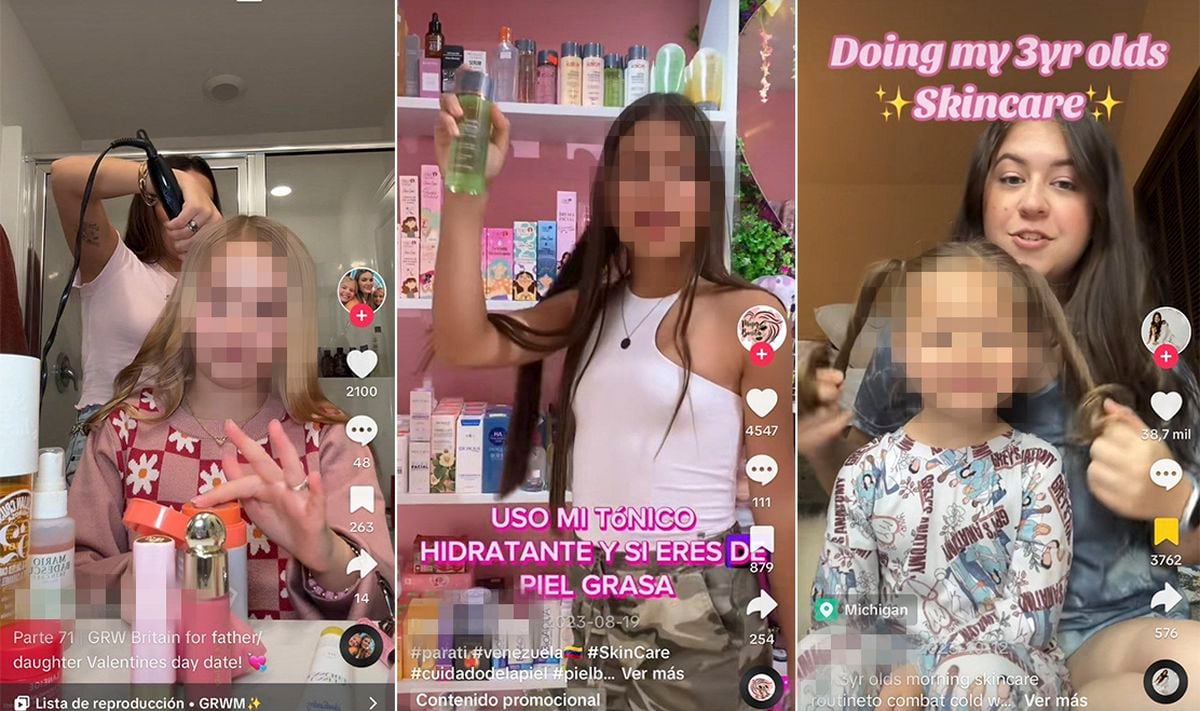(CNN) --
A Minnesota woman unknowingly lost part of her vision and put her entire family at risk of mercury poisoning, most likely from using beauty creams that contained high levels of the toxic chemical, according to a report. case report shared exclusively with CNN.
The report, shared by Dr. Erin Batdorff of the Minnesota Poison Control System, details the extensive symptoms experienced by the woman, also a mother, and how home visits made by the Minnesota Pollution Control Agency (MPCA) , for its acronym in English) found high levels of mercury in their children's rooms, in the bedding, in the towels in the house and in the laundry area.
"People have no idea," Batdorff, a medical toxicology specialist who examined the woman at her home, told CNN.
"No one intentionally wants to harm themselves or their family members. But it's out there and you can't see it, you can't smell it. There's no way [for consumers] to know if [mercury] is in the creams or not because it's not on the labels."
The woman, whose name has been withheld from the report to protect her identity, was referred to Batdorff's team after she reported to several doctors a range of symptoms ranging from insomnia and leg pain to muscle weakness, fatigue and eventually loss of peripheral vision.
Clinical tests revealed elevated levels of mercury in the blood and urine.
Home-made baby food has the same level of toxic metals as commercial options, a study finds
Batdorff explained that the most common symptoms of possible mercury poisoning are tingling or numbness in the patient's hands or feet.
He described the woman's vision loss as "a more extreme and permanent symptom."
"He won't get his vision back," Batdorff told CNN.
"So to be a young woman who now has vision loss is really scary and quite concerning."
advertising
The toxicologist added that there are likely many more people out there who are exposed to toxic levels of mercury and show no symptoms, or at least not yet.
Following the referral, Batdorff and the MPCA visited the woman's home twice, within a year of each other.
On the first visit, the woman showed the team skin-whitening beauty creams from abroad, but said she no longer used them.
The agency found that the amount of mercury in two of those products was several thousand times higher than the permitted levels of 1 part per million (ppm) in cosmetics, and urine tests revealed high levels of mercury in his body (23mcg/ liter), but mercury was not listed as an ingredient in the products, according to the team.
At the time, the agency did not consider the mercury levels in her home to be of concern, but over the course of a year, the mother had increasing levels of mercury in her body, the case report notes.
On a second home visit in 2022, it was discovered that two new beauty products the woman had purchased at a local market, one of which was not labeled as a skin whitener but is known to be used for it, also contained high levels of mercury.
The products found at her home were empty from use, but the MPCA team tested new, unopened versions of the same product, finding extremely high mercury levels of 11,000 and 18,000ppm.
"The outlets are limited and we have no reason or evidence to believe there is any difference in the products," said John Gilkeson, a poison reduction specialist with the MPCA, who conducted the tests at the woman's home and has made three visits to the homes of people who use skin-bleaching creams in the last few years.
New urine tests confirmed that the mercury level in his body had risen to 46.6 micrograms/litre, more than nine times the level considered normal (5 micrograms/litre), and some areas of his home now also contained elevated levels. of mercury, which endangered his family.
Background mercury levels below 200 nanograms per cubic meter (ng/m3) are not considered to be of concern, Gilkeson explained.
However, the children's bedrooms registered levels of up to 400 ng/m3 and their towels up to 600 mg/m3, according to the case report.
Levels of up to 300 mg/m3 were found in the washing machine, where mercury probably accumulated while washing the clothes the mother was wearing, in turn contaminating other clothes and materials that go into the washing machine.
Urinalysis of one of her sons revealed that they now had elevated levels of mercury in her body, although much lower than their mother's, at 6.88 micrograms/litre.
Exclusive: Skin-bleaching creams with high levels of mercury continue to be sold at major online stores, study finds
One of many families in danger
This woman's story is one of many that have occurred in recent years in Minnesota and other parts of the US, where women and entire households are believed to have been exposed to inorganic mercury through the use of prolonged use of skin whitening products that do not disclose that they contain harmful levels of this toxic chemical.
The woman was "incredibly frustrated," Batdorff said.
"She had bought products that didn't say they were bleaches, thinking they would be safe," Batdorff said.
Mercury-containing beauty products remain readily available in local malls and markets across the United States and through online retailers, experts say, helped by the fact that they do not list mercury as an ingredient.
Batdorff and other experts call for increased awareness, regular product testing and stricter enforcement to help combat the problem.
In 2020, a health advisory was issued in Minnesota after a woman suffered kidney damage, a rash, and other symptoms, including insomnia and depression, after using skin-bleaching creams that, again, did not report that contained mercury.
A widespread problem
Screening studies conducted by the biomonitoring team within the Minnesota Department of Health (MDH) in 2015 and 2019 also found elevated levels of mercury in the urine of multiple people who used skin bleaching products. , including pregnant women.
Unpublished results from these studies shared exclusively with CNN show that follow-up visits to the homes of some of these women revealed high levels of mercury vapor in the air, particularly in their washing machines, with readings as high as 1,800 and 2,000 ng. /m3.
Lori Copan, chief of the California Department of Health's Exposure Prevention and Education Section, reviewed the results of the Minnesota mother, telling CNN: "[This woman's case] is unfortunately similar to others we've seen. in California, with a person experiencing symptoms for years without healthcare providers adequately recognizing the potential mercury toxicity of a skin lightening product."
Copan added that her team has seen hundreds of cases of toxicity in people who use these creams, or their relatives.
"Anyone who uses a skin lightening product that contains mercury, unfortunately, is going to put the whole family at risk," Batdorff said.
"There's no way to make sure mercury doesn't contaminate other family members. Mercury doesn't work like that."
The main source of exposure to mercury
Mercury has long been used in skin-bleaching products due to its ability to block the production of melanin, the pigment that gives skin its color.
U.S. Food and Drug Administration (FDA) regulations and the Minamata Convention on Mercury, an international treaty to protect human health and the environment from mercury, limit the use of mercury in cosmetics, excluding those used around the eye area, to 1mg/kg of mercury, also known as 1 part per million (ppm).
Products found in the woman's home ranged from 4,590ppm to 18,000ppm.
Social media is littered with skin-whitening products, but little has been done to regulate their sale.
At high levels, the inorganic mercury often found in these products is extremely toxic.
Chronic exposure can cause kidney and liver damage, as well as neurological damage including personality changes, anxiety, depression, early childhood development problems and, as this case appears to show, vision loss.
"The thing that worries me the most with inorganic mercury is that long-term chronic exposure," Batdorff said.
"It's more subtle, but it ends up building up in our system and it's hard to get rid of, especially when it gets to the brain...and once the mercury has got into the brain and into our nervous system, it can cause a lot of different side effects."
For Batdorff and other experts, it's crucial to find people early and remove sources of mercury before they suffer permanent damage.
"When we're thinking about exposures in pregnant women, women of childbearing age, and infants and children, you know, we don't want people in those groups to have increased mercury exposure," said Jessica Nelson, Program Director for the Minnesota Biomonitoring program within MDH, who led the 2015 and 2019 studies.
"We have to make sure that women know that products can have mercury. And we have to focus on women who speak languages other than English and on different ways to share information, ideally through community partners."
Previous MDH data has revealed that Minnesota's Somali, Latino, and Hmong populations, which are among the largest cultural communities in the state, are at particular risk from mercury exposure in beauty products.
The mother in the case report was originally from Somalia.
"The use of skin bleaching is now a public health crisis in the Somali community and in other communities of color," said Amira Adawe, founder and CEO of the Beautywell Project, which works to address colorism and the harms of bleaching. skin care in Minnesota communities, across the country and around the world.
"I've known some women who have been using these products for 10 to 15 years... [and] I always get calls from people dealing with mercury side effects."
Adawe added that many doctors overlook the need to screen these women for mercury exposure unless they are familiar with the issue of skin lightening practices in the Somali and other communities.
"I would say this is the number one source of mercury exposure for people in Minnesota," Gilkeson agreed at the MPCA.
"It affects the individual who is using the product and it affects their family or their children and their community."
The state health department told CNN that it hopes to work with more clinics and healthcare providers to offer urine mercury screening tests, as well as educate both healthcare providers and the public, with a particular focus on clinics that care for women who may be at higher risk of exposure.
Study links chemicals in cosmetics and toothpaste to osteoporosis
Lack of knowledge among store owners
Earlier this year, the City of Minneapolis conducted a skin lightening education program in collaboration with East African communities at a popular City of Minneapolis community center, the Karmel Mall, as well as other shopping centers in the area.
The goal was to educate people, both store owners and customers, about the risks of mercury found in many skin-bleaching and other beauty products, as well as discuss the wide range of items that are sold in malls to help identify products that pose a higher risk, as well as their countries of origin.
The team spoke to more than 200 vendors and customers and disposed of some 900 products containing high levels of mercury, many of them made in Pakistan, during the three-month program, said Fatou Barry, a program assistant on the project. , who visited the mall almost daily during this time.
Barry said most vendors were unaware the products contained harmful ingredients like mercury and were "shocked" when they realized the risk to their community.
Many others, however, closed their stores when they found out that city officials were visiting, Barry said.
In an analysis outlining the strategy and impact of his team's efforts, Barry wrote that the biggest takeaway from the entire experience was the importance of staying present and engaging with the community.
"Passively sending or posting brochures was not as effective as going from vendor to vendor," she wrote.
Need to improve law enforcement
To address the problem in all affected communities, Nelson of the biomonitoring team believes a multi-pronged approach is essential.
"The urinalysis, the product testing, and the removal of the products from the shelves. The outreach and the engagement with the community," she explained.
"They all need different voices at the table on how to do it better and more effectively."
In addition to these approaches, Adawe stressed the need to improve enforcement.
"The products are widely available in community markets like Karmel and the state has not actively regulated these products," she said.
"I paid a visit [a few months ago] to see if the mercury-containing products we tested were still available...and I saw all the mercury-containing skin lightening products on display on the shelves."
The MPCA is in charge of enforcing the regulations on these products in the state and imposing penalties.
In response to Adawe's concerns, an agency spokesperson told CNN that the MPCA "prioritizes education and outreach efforts to help sellers identify and remove products from shelves and will take enforcement action when appropriate." appropriate".
The MPCA added that "skin lightening creams present a unique challenge because their labeling often does not list mercury as an ingredient and each product must be tested to determine if mercury is present above the regulatory limit."
To increase awareness within affected communities, the Ministry of Health has an Awareness and Education Grant of up to $200,000 to fund various community organizations, NGOs, and municipal health departments working in this area, including the from Adawe.
"Through Beautywell we train healthcare providers and public health workers to understand colourism, the practice of skin lightening and ways in which they can identify the health impact of this practice," Adawe explained.
"The use of skin lightening products in the Somali community is high, so we need to continue to educate this community about health and teach women to accept the color of their skin."
Do you want to know more about products that contain mercury?
If you want to know more about skin whitening and beauty products that may contain mercury, these public health reports and lists identify a wide range available around the world.
The Zero Mercury Task Force created an online database of products known to contain mercury.












/cloudfront-eu-central-1.images.arcpublishing.com/prisa/KMEYMJKESBAZBE4MRBAM4TGHIQ.jpg)


